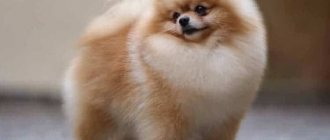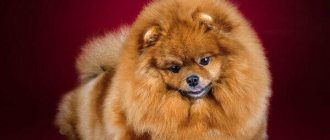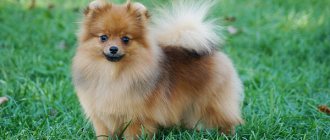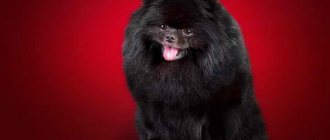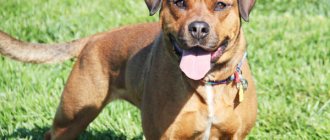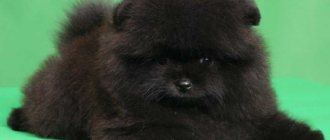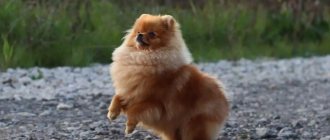In appearance, the orange resembles a cotton ball of wool on thin but strong legs and with an elongated muzzle.
He perfectly combines decorative appearance and impulsive temperament.
Of the Spitz dogs, this is the smallest dog, and if the FCI perceives the Pomeranian Spitz as a variety of the German Spitz in the Pomeranian type, then other cynological federations consider it as a separate breed.
Pomeranian Spitz
Description
The Pomeranian Spitz originated in Germany - Pomerania, where the name of its breed comes from.
It is the smallest variety among the Spitz, which is why for a long time America and Russia called this breed dwarfs or miniature Spitz.
Despite the fact that the Pomeranian is a decorative breed of dog, the pet has good ingenuity and intelligence, so it copes well with the training course.
Photos of dogs
Spitz dogs are distinguished by their miniature size and the unprecedented beauty of their coat - soft, cotton wool with a rich undercoat gives the dog an airy appearance.
No less attention is paid to the thick collar and fluffy tail, which has the habit of resting on the pet’s back.
The dog has medium-sized, dark eyes. The look is attentive, playful.
Due to its light weight, the Pomeranian moves easily and flexibly, and often breaks into a run.
Character
The Pomeranian has a rather impulsive temperament.
The dog is an ardent fan of movement, which is why he will never prefer calmness to active play. He will happily run around the yard and bark, inviting you to share his joy. The pet is also quick to adapt and will happily accompany its owner on trips.
The dog is suspicious of strangers and is unlikely to approach first; he would rather watch the stranger on the sly.
In relations with the owner, the dog often shows stubbornness, moreover, it may try to challenge the leadership in the house. The Spitz is far from a modest dog; it is difficult for her to refuse the opportunity to subjugate anyone.
When a new addition to the family occurs, a dog may even show dissatisfaction, so it is important to raise and train a puppy from childhood. Otherwise, the Pomeranian will be happy to be useful and will happily become a loyal friend for the family.
Owner reviews
When choosing a dog, we decided on a Spitz, and then our eyes widened. A huge number of colors and types. Video reviews from the owners saved the day. Pomeranians and Germans are very similar in character, so we decided not to pay a high price, and also not to spend a lot of time on caring for the 756 coat, and bought a small fox - a German. There is no soul in it.
We thought about it for a long time, but my wife preferred the Mini. The plush baby captivated us at first sight, even from the photo. He was even more beautiful in life. Now we are already adults. There are no special problems in care. We taught our daughter to brush her pet several times a week. In rainy weather, we wear a suit.
Source
German Spitz
Description
It is not for nothing that the German Spitz was classified as a companion dog; at one time the dog served man faithfully, which is why it was in demand among ordinary people for a long time as a watchman. This was even before aristocrats became interested in the breed.
The breed was valued for its loyalty and courage - the dog, despite its small size, bravely rushed to confront offenders and steadfastly endured long expeditions, following its owner.
In general, the German Spitz can boast of a rich history. This is an ancient dog, whose ancestors include many other different breeds.
Photos of dogs
The German Spitz represents a whole group of dogs, which includes large, medium and small Spitz.
However, differences in size do not prevent dogs from having a similar appearance, character and origin. Spitz dogs have the same compact build, thick hair, erect ears, elegant collar, pants and bushy tail.
Character
The German is famous for his balanced character. Long service and rich heritage tell. This is a loyal dog that is highly trainable.
Also, a dog can show itself well in the role of a watchman and notify its owners about strangers by barking. Spitz barks loudly and piercingly, but with proper upbringing, the pet will only give voice on command .
In general, this is an active and lively breed that will never refuse to play. But it will not impose itself if the owner is completely immersed in his own affairs.
Animals know when to stop and make concessions in many ways. Except for those cases when a stranger is walking around the house. Spitz dogs do not favor strangers. On the one hand, this gives dogs an advantage in their career as a guard, on the other hand, it gives them the stigma of being an unenviable neighbor or lodger.
New advertisements. Dog kennel Starpom
There are no ads in this category. Find out more about the dog breed: Pomeranian, dwarf
| The Pomeranian Spitz is a companion dog, very smart, has a developed sense of self-esteem, is devoted to its owner, loves children, is very sociable and affectionate, is easy to train and is not at all whimsical in its maintenance. The Spitz is a dog created for joy and communication with humans. This little dog, with intelligent, expressive eyes and a joyful smile, contains a huge sea of love, devotion to its owner, and a willingness to follow him to the ends of the earth. The history of the Pomeranian Spitz goes back many centuries, where the ancestors of the common Spitz were first mentioned. It is believed that the origin of the species was laid by fossil dogs of pile buildings in Switzerland of the Stone Age, the so-called fossil Spitz of pile buildings or peat dog of the Neolithic period. The habitat of these dogs is Lake Ladoga, where their remains were discovered by archaeologists. Various cultural monuments of Ancient Rome and Antiquity - vases and architectural objects - show us images of small breed dogs that resemble a Pomeranian Spitz. This breed of small dogs goes through all of world history. There is evidence that the miniature Spitz was common during the Middle Ages in Europe, Asia and Africa. This is especially true for countries such as Holland, Germany, Denmark and the Baltic states. | Pomeranian Spitz Dog kennels, Pomeranian Spitz breed, dwarf Advertisements, sale of puppies Pomeranian Spitz breed, dwarf from kennels Pomeranian Spitz, dwarf price |
| more photos Pomeranian Spitz, dwarf |
| Do you like the Pomeranian Spitz breed, dwarf? Vote for her in the breed ranking. |
Find out more about the dog breed: Spitz
The German Spitz has good health, a balanced character, is easy to keep, he is attached to his owner, has an excellent mind and is easy to train. These are very smart dogs, affectionate and diligent. The German Spitz is considered an excellent friend and companion. There are several growth varieties of German Spitz. For each of them certain colors are acceptable.
Weight: Each variety of Spitz should have a weight appropriate for its size. | Brief description of Spitz Dog kennels, Spitz breed Announcements, sale of Spitz breed puppies from Spitz kennels price |
Find out more about the dog breed: German Spitz
| The German miniature (dwarf) and German miniature Spitz are the smallest representatives of the Spitz group. The name of the breed comes from the name of the historical region of Pomerania in Germany, where these dogs apparently originated from. In the 18th century, Spitz dogs were much larger than modern ones, they weighed up to 14 kg, but the selection of puppies moved towards miniaturization and their weight decreased to 5-6 kg. | About the German Spitz breed Dog kennels, German Spitz breed Announcements, sale of German Spitz breed puppies from kennels German Spitz price |
| more photos German Spitz |
What are the differences between the breeds?
Height and weight
| Indicators | Pomeranian Spitz | German Spitz |
| Weight | 2-4.5 kg. | Small (Kleinspitz) - 8-10 kg, medium (middlespitz) - 11 kg, large (grossspitz) - 13 kg, Wolfspitz - 20-28 kg. |
| Height at withers | 18-22 cm. | Small (Kleinspitz) - 22-28 cm, medium (Middlespitz) - 29-39 cm, large (Grossspitz) - 40-50 cm, Wolfspitz - 42-56 cm. |
NOTE!
Only the German Spitz is registered with the Fédération Cynologique Internationale (FCI), while the Pomeranian is no more than one of its varieties. The Pomeranian is recognized as a separate breed by clubs in Canada, England and America (American Kennel Club).
Body type
| Indicators | Pomeranian Spitz | German Spitz |
| Head | In the shape of a cylinder. The forehead is convex, the transition to the muzzle is well defined. The length of the muzzle is slightly shorter than the skull. The general appearance of the head resembles that of a bear. | Wedge shaped. The transition from forehead to muzzle is smooth. |
| Ears | Widely spaced. Small ones. | Closely spaced. With sharp ends. |
| Teeth | Incomplete teeth are acceptable. | Full composition (42). |
| Eyes | Not convex, oval in shape. Dark color. | Small, oval shaped. Dark color. |
| Neck | Short, wider at the shoulders. The fur falls off in the form of a mane. | Set on high. |
| Torso | Square format. | Square format. |
| Paws | Strong, with undercoat. | Small, thin, without undercoat. |
| Tail | Arc-shaped. | Has the habit of twisting into 1-2 rings. |
Simply put, if a dog looks like a little bear cub moving its well-fed legs, then it is an Pomeranian. They, as a rule, have a round muzzle and are slightly pressed down, while the German muzzle is elongated, like a fox. Among other things, the dog is distinguished by a lush mane and sophisticated paws.
Wool texture
The German has two types of hair: the outer coat (long, coarse, straight hair) and the undercoat (short, wavy hair). The animal's coat often puffs up in different directions, which is why the dog looks like a soft toy.
The coat color of the German Spitz is quite varied, but primarily depends on the variety.
The Pomeranian's undercoat is long and the hair tends to resemble a spiral. On the head, this is especially noticeable when the hair folds into the shape of a cap on top, and below it falls in the form of a mane. Pomeranians have weakly expressed guard hairs and the pet's feel can be easily compared to cotton wool.
Acceptable colors:
- black;
- black and tan;
- white;
- cream;
- sable;
- chocolate;
- zonal gray;
- orange.
Character
The Pomeranian has an active lifestyle and a desire to be anywhere and everywhere. These pets are not familiar with the blues; dogs will always find something to do with themselves. In short, Spitz dogs can be characterized as follows: plays, eats, plays, sleeps. And again.
The German is calmer and more balanced. He, of course, will not ignore the game, but if the owner is busy, then the German Spitz will not annoy him and will patiently wait.
Unlike the Pomeranian, who is driven by energy, the German is driven by alertness. These dogs still play the role of a companion for their owners, and therefore it is natural for them to play the role of protector and support for the family.
Expert opinion
Kozhevin Semyon Kirillovich
Expert dog handler.
The main feature by which these breeds can be distinguished is their dimensions. In relation to the German, the height fluctuates between 18 and 55 cm, while the height of the Pomeranian will not exceed 22 cm. This difference is due to the formation of breeds, while life did not spare the Germans, forcing dogs to adapt to survival in the wild and serve ordinary people, the Pomeranians skipped the adaptation process due to its inexpediency. This is an exclusively decorative breed.
Differences
Chanterelles have differences from other types.
From bearish
Spitz bears and foxes are not at all similar. Among dwarf oranges, bear cubs are the most popular and are in high demand. Looking at their appearance, you can immediately notice their characteristic features.
- Bears have a disproportionately large head and a flat muzzle. Chanterelles have a small, wedge-shaped head with a cunning elongated nose that matches the proportions of the body.
- The bear's chin is always raised, so it seems that the baby is looking up. In chanterelles, due to their scissor bite, the chin is generally difficult to find.
- The bear's nose is higher than that of a fox's.
- The ears are small, round, as if buried in wool. They are noticeably different from the pointed, protruding ears of a fox cub.
- The bear's fur, unlike the fox's, is short, like that of a plush toy.
- The body of the robust creatures is wide, reminiscent of real bear cubs, which is strikingly different from the graceful body of the chanterelles.
The bear type is so popular with buyers that breeders often sell dogs that do not meet the accepted standard, which must be culled and neutered to prevent the misbreeding from continuing. Deviations from the standard affect the health and longevity of the pet.
From a toy
The Japanese developed the toy Spitz. It is impossible to distinguish it from a soft toy until the dog begins to move. Until recently, this baby's color was exclusively white. Today they are trying to breed dogs with different shades, they already represent the population at exhibitions, but as before, the most expensive representatives of this group are white, their cost ranges from 25 to 40 thousand rubles. If you compare the toy orange with other types of oranges, it will turn out to be more similar to the bear type:
- the muzzle is like that of a bear cub, only even more flattened, the complete opposite of the elongated fox;
- the eyes are further apart from each other than in other types;
- strong, but not as clumsy as bear cubs, and not as graceful as fox cubs;
- the toy appearance is given by unnaturally thick, pleasant-to-touch fur;
- A distinctive feature of the toy type is its incredibly fluffy tail.
What are the similarities?
If the German Spitz is an officially recognized breed, then the situation with the Pomeranian is somewhat different. Many cynological federations still do not consider this dog as a separate breed, which is why it is one of the varieties of the German Spitz.
As a result, dogs have many common features, be it external characteristics or character.
This is not surprising if a German laid the foundation for the formation of the Pomeranian breed. In an attempt to start a smaller version of it, it happened to breeds that were noticeably smaller in size. This is why the external characteristics of animals coincide so much.
Spitz equally love various games and are gifted with unprecedented resourcefulness, which helps dogs not only solve various dog puzzles, but also skillfully influence their owner in order to get what they want. Still, Spitz are not harmless sheep and will happily take on new heights of the hierarchy.
Both dogs are cold and unapproachable towards strangers. They won’t show aggression, but they won’t happily wag their tail when they see a stranger.
They are much more interested in their household. Animals favor both adults and children. With the latter, you can not only join the game, but also have a little fun.
Origin story
German Spitz dogs formed independently in natural conditions. All that was required of them was health, endurance and easy adaptation to environmental factors. Cynologists consider the turf dog and the pile Spitz to be the ancestors of such domestic animals. Initially, the size of the dogs was 2 times larger.
This is interesting: Peculiarities of feeding Spitz dogs natural food
The Pomeranian species was developed thanks to the long hard work of breeders. They deliberately crossed the German Spitz with dwarf dogs in order to obtain smaller animals as a result. These operations were carried out due to the whim of noble people who wanted to have a beautiful ornamental pet for status and decoration. Here, appearance was of paramount importance, not his skills and security qualities.
Who is more picky about feeding?
Both Spitz are fairly unpretentious animals and, as is typical of many small breeds, have a good metabolism. Therefore, it is not surprising that dogs have a large appetite, which often becomes the cause of obesity.
At the same time, Spitz dogs have a strong need for vitamins and microelements. If the pet does not receive the daily dose of necessary nutrients, this will greatly affect not only the appearance of the pet, but also the functioning of the internal organs.
Pomeranians, like Germans, rarely turn their nose up at a bowl of food . They are not disgusted by the monotony of dishes, but this does not mean that their owners cannot instill in them the same pickiness.
IMPORTANT!
Light-colored Spitz dogs are often susceptible to allergic reactions, so the owner should avoid a number of strong allergens, such as wheat and chicken.
Nutrition
The diet of miniature spitzes must be properly structured; it is this that affects the health of the pet. An adult dog can be fed using one of three methods:
- dry food;
- natural nutrition;
- combined method (natural food and dry food).
Only premium or super-premium food is purchased for animals. Preference is given to food designed specifically for Spitz or toy breeds. Such products contain ideally balanced nutrients and minerals and contain essential vitamins. Popular food brands: Eukanuba, Natural, Acana, Husse and others.
Some owners soak dry food in water in advance. These actions are acceptable, but the food must be diluted in such a proportion that the dog eats it in one sitting. Anything left over should be thrown away. Leftover pieces of food quickly deteriorate and can negatively affect your pet’s health.
Natural food is food not from the owner’s table, but prepared products. Animals will benefit from eating the following foods.
- Lean meats. It can be beef, poultry, beef or chicken liver, heart.
- Give your pet a boiled egg once a day.
- Boiled porridges made from cereals are recommended, with the exception of pearl barley, millet, and semolina. These cereals cause bloating and colic due to poor digestion by the dog’s body.
- The diet includes fruits and vegetables. Potatoes and legumes should not be given.
- The use of fish and seafood is acceptable. Any fish is served boiled, without bones.
- Fermented milk products must be pasteurized. No raw milk.
It is prohibited to feed the animal the following products:
- confectionery products, various buns, baked goods, sweets, any flour products;
- spices, seasonings;
- food with preservatives;
- salted, smoked, pickled, fatty products;
- sausages.
You cannot change the animal’s diet suddenly or frequently. Dietary changes should occur smoothly; within one week it is recommended to introduce or change one type of product. With a combined type of nutrition, natural food and dry food are not consumed at one meal. The diet is structured as follows. In the morning, the animal is given dry food and clean water. For lunch, the pet consumes boiled lean meat or fish products. In the evening he receives a fermented milk product, for example, cottage cheese.
The animal does not need a variety of dishes; one brand of dry food, two types of meat or fish, two or one types of cereals and a couple of vegetables will be enough. The animal must not be overfed. It is necessary to decide on the norm of food consumed and give your pet the same amount of food all the time. The frequency of meals can be divided into larger quantities, but the mass of food consumed should remain the same. Experts recommend the following picture of food consumption. Puppies up to two months eat 6 times a day. From two months - 5 times. From 6 months - 3-4 times. Over 8 months, the animal eats 2-3 times a day, most often the dog is fed in the morning and evening. It is advisable to feed your pet at the same hours.
Comparison of breeds by other criteria
Table of differences between a German Spitz and a Pomeranian on a five-point scale.
| Indicators | German Spitz | Pomeranian Spitz |
| Health | 4 | 3,5 |
| Abundance of shedding | 5 | 4 |
| Attachment to family, home | 5 | 4 |
| Attitude towards strangers | 2 | 3 |
| Attitude towards children and other animals | 5 | 4,5 |
| Guard qualities | 4 | 2,5 |
| Dog bodyguard | 4 | 2,5 |
| Activity | 4 | 3,5 |
| Training issues | 4 | 4,5 |
| Price | From 20 thousand rubles. up to 45 thousand rubles. | From 15 thousand rubles. up to 120 thousand rubles. |
Spitz dogs vary greatly in cost. On the one hand, this is due to the low fertility of the breeds, on the other, Pomeranians from the very beginning positioned themselves as an ornamental breed, so it is not surprising that its price is obviously higher than the cost of its relatives.
How to distinguish puppies
Purebred Pomeranian or German Spitz are very rare in Russia - the RKF allows the crossing of representatives of both species. Therefore, it is becoming increasingly difficult to understand the difference between a German and an Pomeranian. The most common were intermediate dogs called German Pomeranians. They combine signs of two types.
Until three months of age, it is almost impossible to distinguish a Pomeranian from a German Spitz. Externally, the puppies are very similar, but it is very difficult to predict what the pet’s final height will be.
If you need to purchase a purebred animal, you should do the following:
- find a cattery with a good reputation, registered with the FCI;
- study the pedigree - the puppy’s parents may be of the same species, but its grandparents may be different. Puppies from such litters have significant differences and often do not meet the standard.
The weight of a Pomeranian puppy at 3 months should be less than 1 kg. If the animals are heavier, most likely they belong to the Small Spitz group.
Unscrupulous breeders pass off large, younger Spitz dogs as miniature Pomeranians. To avoid mistakes, it is recommended to buy grown-up juniors. Also, during molting, it is easier to notice differences in body structure.
The cost of puppies is approximately the same:
- pet class - 20-25 thousand rubles;
- breed class – 30-50 thousand rubles;
- show class - from 70 thousand rubles.
It is better not to buy from the hands of animals - you can buy a sick dog or a pet that has striking differences from the standard.
To breed Germans, an exhibition rating of at least “very good” and a pedigree are required. In England, the USA and Canada it is allowed to crossbreed all dogs that have official documents.
To whom and who will suit?
The German Spitz has an easy-going character. This is a very balanced animal with unprecedented wariness towards everything alien and incomprehensible.
Hereditary qualities are felt, encouraging one to preserve and protect the family. The aboriginal way of life has instilled many traits: over the long history of the breed’s formation, the dog has become accustomed not only to being close to its owner, but also to vigilantly observing its surroundings. Therefore, the German will become a desirable pet and a wonderful friend for both elderly people and people with disabilities.
The Pomeranian loves movement, and he would be happy with owners who share his passion.
This is an active and cheerful breed that finds it difficult to sit in one place, so the pet will easily take root in families with children and other pets, largely thanks to the ability to find a common language with anyone.
However, this does not apply to very young children who have not yet learned to distinguish between what is and is not possible. The Pomeranian cannot boast of its size, and playing with children can often cause accidents.
Spitz dogs are convenient for people living in apartments, both large and small. Fortunately, pets are unpretentious and do not take up much space.
NOTE!
Another thing is issues of education. German and Pomeranian Spitz require a lot of attention. Their owner must be able to find the time and desire to instill in the pet the basics of training, otherwise the pet’s behavior will become a problem in the future.
Health
In most cases, the average German Spitz is distinguished by excellent health and good heredity. If diseases begin to appear, this is explained by genetic mutations or breed predisposition. Most often, dogs bought outside the kennel without a pedigree get sick.
The most common diseases for the breed are:
- Fractures, displacement of bones and joints, sprains. The weak point is the hip bones and knee joints. They are the ones that get damaged most often. In most cases, this is due to the dog’s energy and mobility, but sometimes the cause is dysplasia, a congenital pathology of underdevelopment.
- Eye diseases. The most common are retinal atrophy and tear duct abnormality. This is due to the structural features of the skull and refers to breed defects. Increased tearing may occur as a symptom of an allergy. It goes away on its own after the pathogen is eliminated.
- Problems with teeth occur during the change from milk teeth to permanent teeth. But such as tartar can accompany a Spitz throughout its life.
- Collapse of the larynx. The reason is the structural features of the trachea.
With improper care of the coat, poor immunity or lack of vitamins in the diet, alopecia may occur. Baldness can affect up to 60% of the coat. The first sign of the disease is profuse loss of guard hair and the appearance of bald spots on the tail and hind legs.
Hair loss is often caused by hypothyroidism, a dysfunction of the thyroid gland or a deficiency of its hormones. In this case, it is necessary to show the dog to a veterinarian and conduct a full examination to rule out other diseases.
The most common hereditary disease is angiohemophilia (von Willebrand disease). It causes spontaneous bleeding associated with bleeding disorders and is difficult to diagnose.
The puppies are just adorable
Character
Spitz are among the smartest dogs on the planet. They are very smart and easy to train.
These little dogs are very loyal to their owner. They constantly demand attention and use any means to attract it. They jump, bark, circle, tag along, and can grab objects to force a person to take them away. Spitz constantly tries to establish tactile contact with a person. He is able to sense the owner’s mood and adapt to it.
On the one hand, Spitz are very distrustful of others. They can be aggressive with strangers, especially if they smell, for example, alcohol. At the same time, these are one of the bravest dogs. They are ready to protect their owner and often try to start a fight with larger animals.
Thanks to their keen mind, Spitz dogs often perform incredible tricks, never ceasing to amaze their owners.


